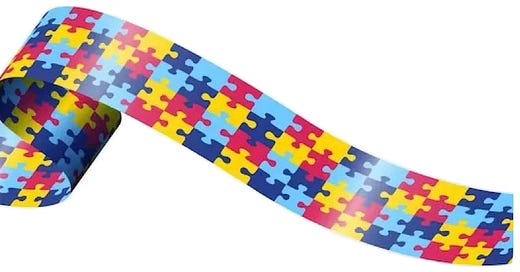The puzzle piece, a known symbol of autism, has significantly changed shape, color, and societal meaning over the years.
Created by Gerald Gasson, a non-autistic board member of the National Autistic Society, in 1963, its initial portrayal of a distressed child carried negative connotations associated with autism.
In 1999, the Autism Society of America, led by non-autistic individuals, introduced the Autism Awareness puzzle piece ribbon.
This symbol aimed to represent the intricate nature and varied manifestations of autism while also serving as a beacon of hope through heightened awareness and support.
Despite the well-intentioned efforts to redefine its meaning, the puzzle piece continued to carry distressing connotations stemming from its earlier associations.
Before 2008, the puzzle piece symbol did not portray autistic individuals as part of a puzzle. Instead, it underscored the lack of understanding among neurotypical individuals.
Autism Speaks played a significant role in popularizing the use of the puzzle piece in major awareness campaigns, leading to its widespread adoption as the symbol of autism. However, by 2008, opposition against the puzzle piece symbol began to grow.
Critics argued that the continued use of the puzzle piece reinforced the notion that autistic individuals were inherently puzzling or odd, perpetuating the idea of them as a mystery to be solved.
In 2011, Autism Speaks inadvertently contributed to this negative representation by suggesting that autistic individuals were the puzzle represented by their logo.
For many within the autistic community, the autism puzzle piece symbol carried negative connotations.
In 2011, Virginia Tech English Professor Paul Heilker and Ph.D. candidate Melanie Yergeau publicly criticized the symbol by pointing out its harmful implications. Their criticism sparked a wave of increased scrutiny that led to a loss of respect for Autism Speaks within the autism community, reducing positive representation and information about autism.
Despite attempts to rebrand in 2020 by adjusting the colors and shape of its puzzle piece symbol, Autism Speaks failed to regain support from the autism community.
Eventually, Autism Speaks responded to the concerns of autistic individuals by removing the puzzle piece from its branding altogether.
Associated with neurodiversity, the rainbow infinity symbol is a beacon of positivity and acceptance, starkly contrasting the negative associations often tied to the puzzle piece.
Amelia Blackwater, recognizing the importance of representing the diverse spectrum of the autistic community, proposed the adoption of the rainbow infinity symbol to foster a sense of autistic positivity.
In February 2018, a golden infinity symbol emerged as a new emblem for autism, symbolizing the rich diversity within the spectrum and signaling hope for a brighter future.
About ALLLI Solutions:
ALLLI Solutions empowers individuals to become impactful disability advocates by fostering education, empathy, and actionable awareness. Our mission is to create environments where acceptance, inclusion, and equity thrive—whether in classrooms, workplaces, or communities. Through compassionate guidance and professional training, we inspire meaningful change, amplify diverse voices, and work together toward a world where every individual, regardless of ability, can belong, contribute, and succeed.
To learn more, please visit alllisolutions.com








